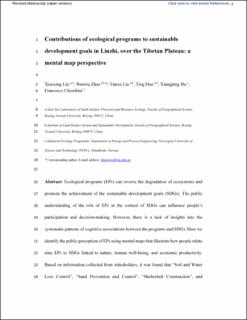| dc.contributor.author | Liu, Xiaoxing | |
| dc.contributor.author | Zhao, Wenwu | |
| dc.contributor.author | Liu, Yanxu | |
| dc.contributor.author | Hua, Ting | |
| dc.contributor.author | Hu, Xiangping | |
| dc.contributor.author | Cherubini, Francesco | |
| dc.date.accessioned | 2022-03-28T12:39:07Z | |
| dc.date.available | 2022-03-28T12:39:07Z | |
| dc.date.created | 2022-01-10T09:56:11Z | |
| dc.date.issued | 2022 | |
| dc.identifier.citation | Ecological Engineering: The Journal of Ecotechnology. 2022, . | en_US |
| dc.identifier.issn | 0925-8574 | |
| dc.identifier.uri | https://hdl.handle.net/11250/2988053 | |
| dc.description.abstract | Ecological programs (EPs) can reverse the degradation of ecosystems and promote the achievement of the sustainable development goals (SDGs). The public understanding of the role of EPs in the context of SDGs can influence people's participation and decision-making. However, there is a lack of insights into the systematic patterns of cognitive associations between the programs and SDGs. Here we identify the public perception of EPs using mental maps that illustrate how people relate nine EPs to SDGs linked to nature, human well-being, and economic productivity. Based on information collected from stakeholders, it was found that “Soil and Water Loss Control”, “Sand Prevention and Control”, “Shelterbelt Construction”, and “Wetland Conservation” were indicated as the key programs for the achievement of SDGs in Linzhi. The mental map of the majority of the people identified trade-offs between the environmental/social and economic sustainability elements supported by EPs. Some people related multiple EPs to social and economic sustainability elements, while others primarily saw multiple EPs as targeting the environmental and economic sustainability elements. The dominant mental map here identified could serve as a model for engaging in, and communicating, ecological programs. We suggest a direction for addressing SDG trade-offs through ecological program-based management, which is based on three aspects: priority adjustment, integrated portfolio, and stakeholder engagement. | en_US |
| dc.language.iso | eng | en_US |
| dc.publisher | Elsevier | en_US |
| dc.rights | Attribution-NonCommercial-NoDerivatives 4.0 Internasjonal | * |
| dc.rights.uri | http://creativecommons.org/licenses/by-nc-nd/4.0/deed.no | * |
| dc.title | Contributions of ecological programs to sustainable development goals in Linzhi, over the Tibetan Plateau: A mental map perspective | en_US |
| dc.type | Peer reviewed | en_US |
| dc.type | Journal article | en_US |
| dc.description.version | acceptedVersion | en_US |
| dc.rights.holder | This is the authors' accepted manuscript to an article published by Elsevier. Locked until 10.1.2024 due to copyright restrictions. | en_US |
| dc.source.pagenumber | 9 | en_US |
| dc.source.journal | Ecological Engineering: The Journal of Ecotechnology | en_US |
| dc.identifier.doi | 10.1016/j.ecoleng.2021.106532 | |
| dc.identifier.cristin | 1977202 | |
| dc.relation.project | Norges forskningsråd: 286773 | en_US |
| cristin.ispublished | true | |
| cristin.fulltext | postprint | |
| cristin.qualitycode | 1 | |

